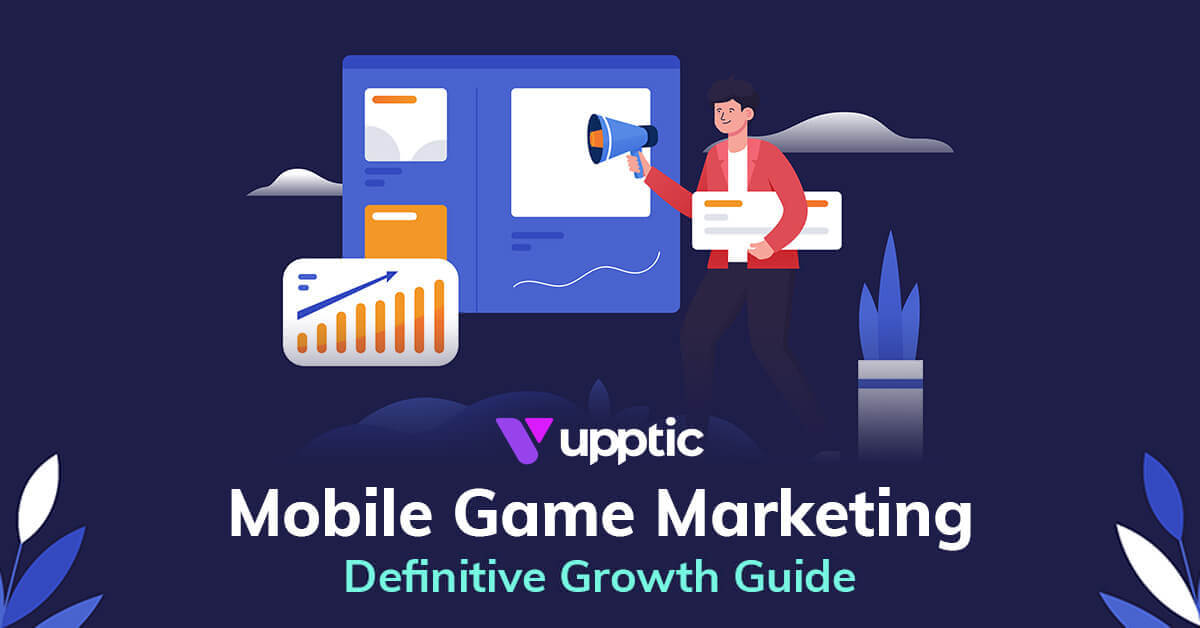In our definitive guide for mobile game growth insights, learn what to do during game development, game launch, and post-launch to maximize your user acquisition.
Use this chapter selector for quick access to specific parts of this mobile game marketing guide:
- The mobile game and marketing industries
- Marketing in game development
- Pre-launch and game launch marketing
- Soft-launching your game
- Marketing through organic engagement
- Marketing through advertising
- Data and analytics
- Key takeaways
The mobile game and marketing industries
Mobile game marketing sits at a cross section of two industries: the mobile game and the mobile marketing industry. Both have been undergoing major changes and disruptions in the last few years.
Mobile game industry
The mobile gaming industry really kicked off with the launch of the iPhone and its associated App Store in 2009. Over the years, the mobile game industry has seen ebbs and flows, but has largely been on an upward trajectory in terms of revenue and market saturation. Some popular mobile games include Candy Crush Saga, Genshin Impact, Angry Birds, Pokémon Go, and Clash of Clans.
Over the last few years, the mobile gaming industry has been bolstered by the COVID-19 pandemic, as more people turned to virtual worlds since they couldn’t go out into the real world. However, as things return to a sense of normalcy, those gains have dissipated – with a recent report suggesting that overall revenue has declined 10% in the first half of 2022.
Additionally, Web3 has disrupted the games industry through new technologies, growing interest, and major fundraising. However, with millions of mobile gaming apps out there in the mobile gaming market, competition is incredibly stiff for those making a new mobile game app no matter what.
Mobile marketing industry
The mobile marketing industry has had a turbulent few years as well. Apple has continued to change the way users and ads are tracked on iOS with their privacy initiative, App Tracking Transparency (ATT), and their associated SKAdNetwork. Meanwhile Google is looking to take similar steps with its Android OS and Chrome browser. The simple truth is that traditional mobile marketing is going to be an uphill battle for years to come.
Marketing in game development
People often think of mobile game marketing as something that happens at mobile game launch and beyond. But if you want to increase the odds that your mobile game will be a hit, you should have a mobile game marketing strategy that includes mobile game development as well.
Here are a few key ways to utilize marketing in conjunction with mobile game development.
Market research
While the competition for users and revenue is stiff across the board – building a successful games business is an exercise in finding untapped markets and building great products to fill those niches . When it comes to building a mobile game, it is worthwhile to research different genres, countries, and audience archetypes to find demographics that may benefit from more mobile gaming options.
Finding a niche and growing into it is becoming more and more important for finding success in an increasingly oversaturated market.
Target audience
Honing in on a target audience early – as opposed to at mobile game launch or after release – can make it much easier to create a mobile game that people are receptive to and enjoy. Once you’ve found a good audience to go after in your market research, make sure to do your homework on them to find out their likes and dislikes when it comes to art, music, mobile gaming mechanics, narratives, purchase habits, playing habits, and which mobile device they tend to use. Creating a persona for each type of gamer you are going after makes it easier to know where you should be spending your ad money and organic marketing efforts.
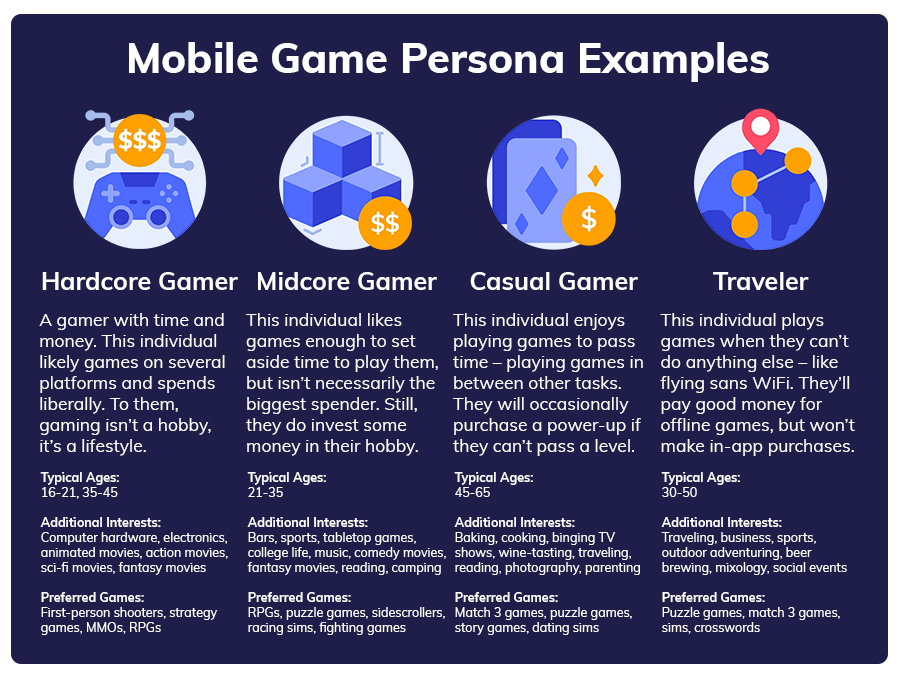
Competitive research
Once you’ve got your audience and mobile gaming genre figured out, it’s time to take a look at the competition. Read up on news stories, check out their ads, read reviews from their users, and play their games. Discover what they do well and what they don’t do well – and build a game that capitalizes on this information.
App store research
Typically speaking, a multi-platform approach will cast the widest net to reel in the most users. However, given the differences between app stores, this isn’t always a feasible or sensible option. Make sure to do a cost-benefit analysis of taking a multi-platform approach vs. targeting specific app stores.
Every app store’s users are a bit different as well, so you want to make sure you’re eyeing app stores that make sense for your game.
For instance, Steam is focused on gaming – so a hardcore gaming app or video game might do better there. Meanwhile, Apple App Store users tend to spend more on apps (and in app purchases) while highly successful Google Play games tend to be more ad-driven. However, both freemium and premium games can do well in any mobile app store.
Tools and resources
There are plenty of resources available to help you with market and audience research, scoping out the competition, and keeping up on app store trends. Among the most well-known of these are Apptopia, SensorTower, and Data.ai (formerly App Annie).
Pre-launch and game launch marketing
As you get closer to your mobile game’s launch and ultimately launch your game, there will be a whole new list of to-do items for your marketing team. These are necessary for making sure your game is seen in the right places to reach your target audience.
App Store Optimization: Product pages
Getting your app store product pages right is incredibly important for both user acquisition and organic user conversion. The name, icon, trailer video, and many other aspects of the product page can reel someone in and convince them to download your game – or cause them to gloss over your app altogether. A/B testing different elements of your app store product pages is essential to increasing impressions and installs.
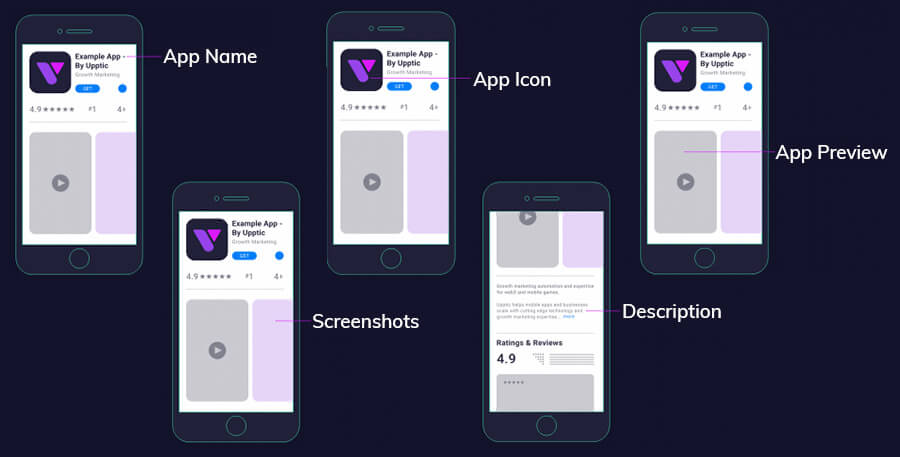
App Store Optimization: Keywords and categories
Tying into your app store product page is app store optimization. While A/B testing product page elements is a portion of this, it also goes deeper. Selecting the right keywords and categories for your app can be the difference between ranking in the Top 10 or showing up farther down the list. It’s important to continuously iterate and measure performance of your app store listings.
App Store Optimization: Reviews and feedback
There are typically two ways that a mobile game can increase exposure in an app store: By having a high amount of downloads or a high user rating. Keywords and product page iteration can help with the first, but the second comes down to simply having a solid mobile gaming experience and being responsive to customer issues. Don’t neglect disgruntled users. Make sure you are reading and responding to the reviews you garner on your app store product pages – and fixing the problems they highlight.
Partnerships
Forming the proper partnerships can help a game grow organically, especially in the early stages. One great place to find partners are in online communities that you believe will resonate well with your game. Reach out to their leaders with ways to engage with their community in a mutually beneficial manner for everyone. This can mean offering early access to the game in exchange for feedback, providing discount codes, taking part in AMAs, and more.
Outside of online communities you may find great partners in like-minded game developers – opening the door for cross-promotion and other growth opportunities. Partnering with podcasts, webinars, and events are other great ways to grow your footprint and raise awareness of your brand and games.
Content marketing
When it comes to launching and promoting a game, it helps to have an active website. Content marketing is not only a great way to keep mobile gamers up to date on your games and provide insights to your colleagues – but it’s also great for increasing SEO and making you more visible in web searches.
Publishing regular articles, white papers, opinion pieces, game updates, case studies, and more is a great way to grow your brand awareness and raise your company’s profile.
Press and PR
Any game launch is incomplete without getting news organizations involved. Make sure you’re reaching out to websites, magazines, newspapers, and other such organizations that cater to the audience you’re targeting.
Share screenshots, videos, and development progress, allow them to review your game, and highlight what makes your game and company unique. Games that have unique angles or mechanics are likely to be of more interest – as are companies with unique backgrounds or praiseworthy missions.
Consider going multi-platform
As mentioned in the section above, going multi-platform casts the widest net possible for user acquisition. While everyone should do a cost-benefit analysis, many game developers tend to at least release games on both the Apple App Store and Google Play store – as these cover roughly 98% of mobile devices.
Tools and resources
There are several companies that can assist with app store optimization, such as Upptic. Newswire.com can assist with press releases and news outreach. And Moz, Ahrefs, ClearVoice, and MarketMuse can assist with content marketing and SEO.
Soft-launching your game
Part of the pre-launch process, a soft launch is when you take your game live in order to test and iterate your game and its supporting app marketing initiatives. Typically the soft launch is limited to a few small geos at first, and focuses on refining the game’s tech, then retention, and finally monetization.
As the initial tests see good progress in user acquisition, more valuable geos are added and the tests are phased up – until the full global launch of the game.
Marketing through organic engagement
Organic engagement is an ideal way to grow a game because it’s free – or at least cheaper than using ad campaigns. This is because you’re generally only paying for a social media manager and possibly social media management software. Meanwhile, with ad campaigns you’re typically paying for an ad manager, an ad management platform, creatives, and ad inventory.
But organic engagement definitely takes the right person and tools for the job. Here’s how to make sure you’re doing organic engagement right.
Channel distribution
A social media presence is a must. Do your research to find out where your audience is most likely to be and make sure to build social media profiles on those platforms. Learning where your competitors are engaging with their users can be a big help and identifying where you should be most.
One thing you should not do is try to be everywhere. Keep the focus on finding the channels with the best ROI for engaging with your audience.
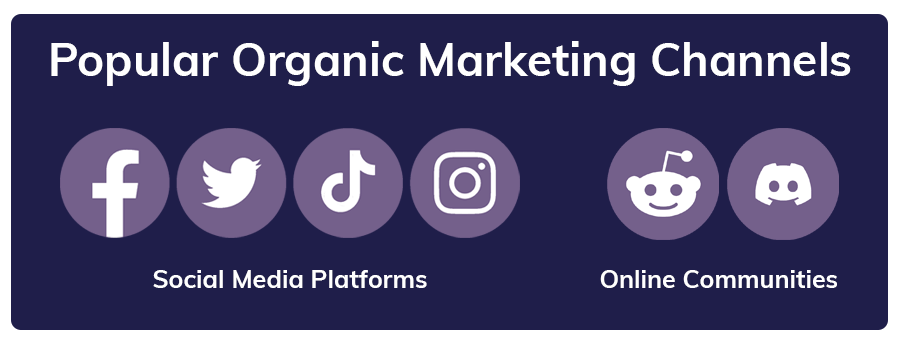
Social media
Each platform has its own best practices as well. On some you should be posting multiple times a day, on others once a day is more appropriate. On most, live videos are paramount, on others images and infographics make more sense.
Once you’ve got a handle on the best practices, make sure you’re engaging your audience. Solicit suggestions, respond to questions and comments, and make them a part of what your company is doing.
Posting fresh content is ideal as well (which your content marketing strategy can help with).
Communities
Online communities are places where people congregate around a single topic – subreddits, Facebook groups, and Discord servers being some of the most common examples. Search out and become active in the groups your audience tends to take part in.
This doesn’t mean joining a community and shamelessly promoting your game. You should be thoughtful and genuine in your approach to engagement. Take part in the community as an earnest participant and mention your company and games when it makes sense.
Being a moderator, doing AMAs, and hosting in-community events can be a great way to organically promote yourself, your company, and your games.
User Generated Content
User generated content (often abbreviated UGC) is any content created by your users or followers. This includes fanart, cosplays, mods, and more. Encourage your users to create content by sharing the content they create enthusiastically.
In many Web3 games this takes on an extra dimension of significance as community members not only generate in-game assets, but also own those assets. These in-game assets can be traded in marketplaces and even potentially be used in other games on the blockchain. Since these in-game assets are built and owned by the players, not the game developers, players have a sense of ownership and connection to these games that cannot be found elsewhere.
The best (and cheapest) promotion is always word-of-mouth – and user generated content is often simply enthusiastic support for a product or service. So having something that people can connect to and fall in love with is key.
Channel optimization
While there are best practices for each platform, these are always, at best, general guidelines. Make sure you’re studying each platform’s analytics so you can see what type of engagement is working best for your specific audience, when your posts are being seen most, and what content your audience is most receptive to.
Continue to iterate and tweak your social media strategies based on the latest data on a regular basis. This will ensure you’re getting the most organic uplift possible.
Tools and resources
When it comes to social media management platforms, some of the most well-known are Hootsuite, Loomly, and SocialPilot. Additionally almost every social media platform has an internal analytics dashboard for business accounts which you can use to learn more about your audience and their habits and preferences.
Marketing through advertising
Traditionally, advertising has been a major tentpole of any marketing campaign. The mobile advertising ecosystem is complex – with many options when it comes to ad formats and targeting. Here is a run down of some of the most common ad types – as well as some of the largest elements of the mobile ad ecosystem.
Ad Formats
When it comes to making a mobile game ad, there are several different types of creatives for mobile marketers to choose from – with some being more engaging than others.
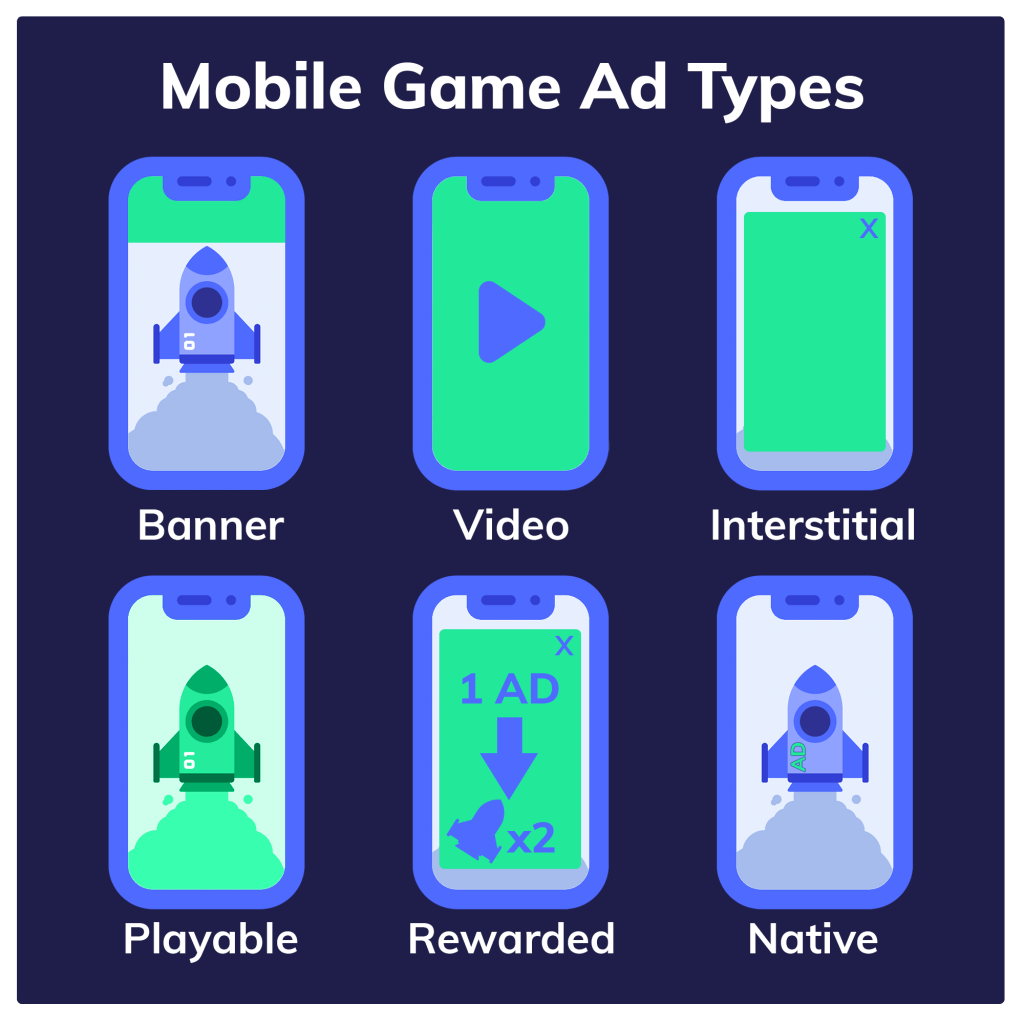
Video ads and rewarded video ads
Video ads are among the most popular ad formats because they are more engaging than static ads and tend to convert better. Some good rules of thumbs for video ads are to study competitor ads, include gameplay footage, keep them between 15-30 seconds, include captions, and start with an eye-catching opener.
Rewarded video ads are a subset of video ads where mobile gamers within a game are rewarded with in-game currency or items for watching a video ad. These are among the most effective ads because they are opt-in and allow for a “captured” audience experience.
Playable ads
Playable ads allow ad viewers to sample your gameplay within an ad unit. These can be great for conversion as someone who has enjoyed playing your game is much more likely to purchase and/or download it.
Make sure you are putting your best foot forward if you make a playable ad. You don’t want people to have a buggy or underwhelming experience. Feature an exciting game moment with mechanics that are easy to understand but also set you apart from other games. Would-be players should walk away with a feeling of accomplishment.
Static ads
Static ads are simply ads that feature pictures or graphics, rather than video or gameplay. These often include banner ads and interstitial ads in games. When it comes to images, as with most ads, simple is best. Feature your main message in big letters alongside your branding, and a CTA – all encompassed by a compelling visual.
Additionally, you will want to tailor your ads to the standards of whatever platform you’re releasing them on. These can change fairly regularly – and different on the mobile and web versions of the platform – so make sure to look up the latest standards of the platforms you’re using.
Native ads
Native ads are ads that blend seamlessly into the surrounding environment and don’t look much like an ad at all. Product placements are great examples of native advertising. More examples of native ads include an in-game billboard ad or radio ad for a real out-of-game product or service.
Search ads
Search ads, such as an Apple Search ad or a Google Search ad, are text ads that show up at the top of relevant search results. While they look like other search results, they are typically marked as ads in order to be fully transparent to users. However, they are an effective way of getting seen by people who are actively looking for games like yours.
Ad networks
Ad networks essentially act as a broker between mobile game publishers and digital advertisers. Mobile game publishers list their available inventory (ad space) to the ad networks and the digital advertisers can then purchase those placements through the ad network.
Advanced ad networks employ real-time bidding (RTB) systems, where advertisers set a maximum bid for a piece of inventory. The RTB system automatically collects the bids for the inventory with the highest bidder winning the auction – meaning their ad is seen by a user in the publisher’s mobile game.
Influencers
Influencers are people with a large following on social media. They’re called influencers due to the idea that they can influence the purchasing habits and attitudes of their followers. Influencers have proven to be a mixed bag for marketers. While most marketers seem to agree that mobile game influencer marketing is effective, quantifying the results of mobile game influencer marketing can be difficult.
That said, there are a couple key takeaways to keep in mind if you decide to work with gaming influencers. The first is that it’s not just all about followers. You want to make sure you’re working with influencers who engage with their audience – and do so in a genuine and authentic way. Some micro-influencers can do more for you than gigantic influencers.
The second takeaway is that long-term relationships, often called “brand ambassadorships” tend to work better than one-off product placements. Cultivating trust and loyalty takes time – not just between your company and influencers, but also between influencers and their followers, and their followers and your company.
Experimenting, measuring, iterating
Regardless of what kind of ad campaigns or partnerships you run, the key is to experiment with formats and ideas, measure results, and iterate on what you learn. Even when you find something that works well, chances are there will be diminishing returns over time due to ad fatigue and other factors.
So never rest on your laurels, always be looking for the next great eye-catcher and next great converter.
Tools and resources
There is an ocean of tools and resources for ad campaigns. Most platforms have their own internal tools and resources for running native ad campaigns.
Companies like AppsFlyer, Singular, and Adjust can assist with ad campaign attribution and measurement while ad networks like AppLovin, ironSource, and Unity allow you to tap into advertisers in need of inventory.
When it comes to ad creatives, companies like Upptic can help you create compelling videos, measure ad efficacy, and manage relationships with ad networks.
Finally, websites like JetFuel and Influencer Marketing Hub can help you connect to influencers and gauge how much you should be paying them.
Data and analytics
Throughout this article, the topics of measurement and iteration have continued to pop up. This requires a solid understanding of analytics, attribution, buying models, and other data-dependent marketing methods and tools. Here is the need-to-know.
Mobile marketing attribution
Attribution is a type of marketing measurement that seeks to determine which marketing actions are contributing to conversions. Various attribution methodologies – such as first-touch, last-touch, and multi-touch – can be used to take user data and suss out the effectiveness of marketing campaigns through deterministic analysis. In the mobile games marketing industry, the most common attribution methodology is “last-touch”.
Since effective attribution is dependent on user data, changes in privacy and data rules, regulatory changes, emerging technologies like blockchain, and consumer attitudes have upended traditional attribution methodologies. This has caused the industry to continue evolving how it measures marketing conversions.
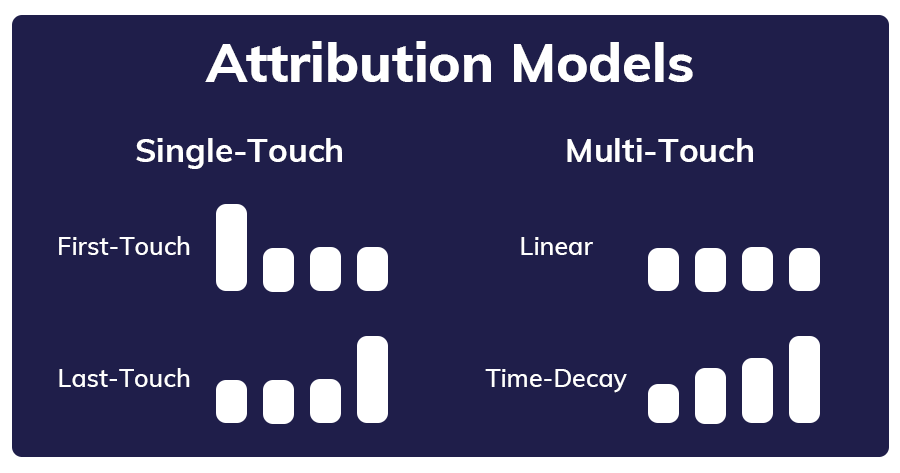
ATT and SKAN
App Tracking Transparency, or ATT, is a change to Apple’s privacy and data collection policies that took place in early 2021. It requires marketers to get permission from users to track them. StoreKit Ad Network, often referred to as SKAdNetwork or SKAN, is Apple’s way of allowing marketers to measure conversion rates of app install campaigns without compromising user identities.
ATT and SKAN have caused problems across the mobile marketing ecosystem. Nonetheless, anyone who wants to work with Apple iOS must abide by them. So instead the focus has shifted from simply collecting data to getting users’ permission to collect data.
To that end, some best practices include making a compelling case for how gathering a user’s data will enhance their experience with your product and making use of the pre-prompt feature Apple provides companies for making their case to users who are about to choose whether to opt-in to data collection. Additionally, some companies like Upptic have produced proprietary analytics systems that greatly simplify measuring iOS users in the SKAN era.
Organic uplift
Organic uplift refers to the phenomenon where paid installs result in additional organic installs. This can be due to many factors, including word of mouth, going viral, seeing the game higher up in lists on app stores, appearing more often in search results, etc.
In addition to this, organic uplift can also refer to users who see a CTA and do something else instead – making them unattributable as a paid install. For instance, someone who sees an ad for your app, but then searches for your website and checks it out and installs your app from there is an example of organic uplift.
Measuring organic traffic is essential for forming a complete picture of your users and their habits and behaviors. That said, it is very difficult to measure as well. The easiest way to measure organic traffic is to be meticulous in tracking all installs and then removing paid installs from the equation to learn more about your organic traffic.
Media buying models
Media buying models might sound complex, but are a bit more simplistic in reality. They are simply different ways to purchase media or ad inventory. There are several different kinds of media buying models – including CPC, CPM, CPI, and more.
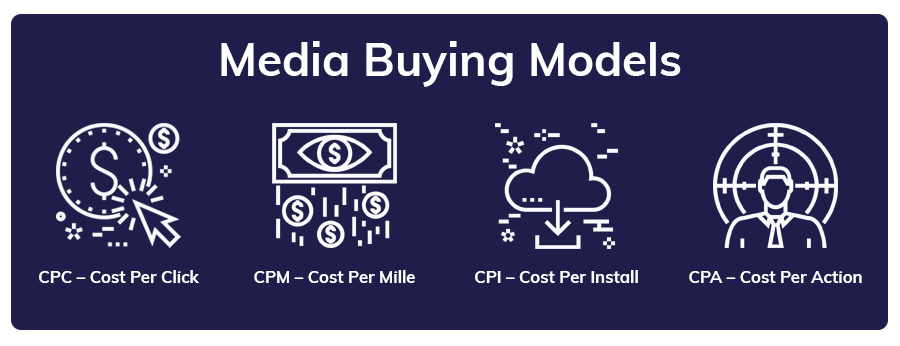
CPC – Cost Per Click
CPC is one of the most common media buying models. In CPC, an advertiser pays a vendor, such as a game developer, for every click on their ads. These are especially common for campaigns where the goal is to drive traffic to a certain place.
CPM – Cost Per Mille
CPM is probably the second-most common media buying model. In a CPM campaign, the advertiser pays for every 1,000 impressions or ad views (mille being Latin for 1,000). These are great for when you want to raise awareness but don’t necessarily need to drive traffic anywhere.
CPI – Cost Per Install
In CPI campaigns, advertisers pay for every install that can be attributed to an ad placement. This can be great for increasing your install rate, but the quality of installs can vary from vendor to vendor. CPI campaigns are best coupled with robust retention and retargeting campaigns.
CPA – Cost Per Action
In a CPA campaign, the advertiser pays the vendor whenever a user performs a specifically defined action – whether that be a click, install, or something else previously agreed upon.
Modeling for incomplete data
Naturally, when it comes to organic uplift, ATT and SKAN, ads over TV and radio, or any number of other issues, you simply won’t have all the data you need to make data-driven decisions.
Mixed Media Modeling
For these scenarios, there is marketing mix modeling, also known as media mix modeling. This is an analysis technique that helps marketers measure the effectiveness of their marketing efforts in driving conversions.
Any media mix model should include the marketing channels you’re using, the money you’re spending on each channel, and the results of that spend. Done right, these can give you insights on how much money you’d have to spend to see an x-percent increase in installs, predict future conversions, and distinguish high-ROI channels from low ones.
Tools and resources
The internet and world is awash in resources for data and analytics. Not only do most social media platforms and ad platforms have their own measurement tools, but there are also many third-party providers you can plug their data into for aggregating everything in one place.
For attribution you can look toward AppsFlyer, Singular and Adjust. Ad platforms such as Facebook, Twitter, Google, Apple Search, and ironSource typically provide a variety of media buying models to choose from – and companies like Upptic can help you make sure you’re making a profit.
Key takeaways
Growing a game’s userbase takes time, effort, and a multi-pronged approach. A single channel will not net you success. Spending money on ads alone will not net you success.
You must nurture both organic and paid channels in a holistic manner and meticulously track your ROAS (return on ad spend) to ensure that the money you’re spending is worthwhile and the places you’re spending it have a high ROI (return on investment).
It’s not something that can be undertaken alone. It will require partners – whether they be agencies, ad platforms, influencers, or a combination of these.
We at Upptic would love to help you get started.
SOURCES
https://www.gamesindustry.biz/how-the-covid-19-pandemic-is-changing-the-mobile-games-market
https://www.destructoid.com/mobile-games-revenue-decline-2022-financial-sensor-tower-stats/
https://qz.com/1997873/apples-idfa-privacy-update-threatens-to-upend-the-ad-industry/
https://www.marketingdive.com/news/google-sets-its-own-shakeup-to-mobile-ad-ids-promising-less-blunt-approa/618947/
https://www.cookiebot.com/en/google-third-party-cookies/
https://www.androidauthority.com/google-play-store-vs-apple-app-store-744204/
https://www.statista.com/statistics/272698/global-market-share-held-by-mobile-operating-systems-since-2009/
https://www.blog.udonis.co/mobile-marketing/mobile-games/mobile-game-marketing
https://instapage.com/blog/image-ad-best-practices
https://www.tribegroup.co/blog/influencer-marketing-worth-it
https://www.singular.net/glossary/skadnetwork/
https://www.appsflyer.com/blog/measurement-analytics/organic-uplift-multiplier-app-marketing/
https://matchmade.tv/blog/why-you-should-be-measuring-organic-uplift/
https://www.marketingevolution.com/marketing-essentials/media-mix-modeling
https://trackier.com/blog/6-different-media-buying-models/

